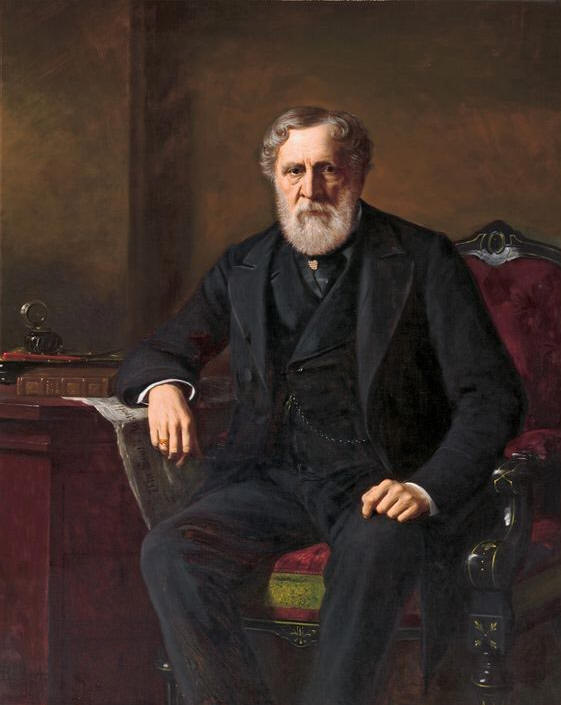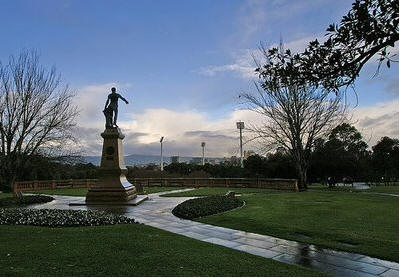 |
|
 |
| |
|
|
Portrait
of Jacob Barrow Montefiore #456 (b1801 Barbados;
d1895 England)
Painted about 1870
by British painter
Barnett Samuel Marks
1827-1916.
Presented to the
Adelaide Art Gallery by the subject in the 1892-4
period (see
ref 284).
A brief biography
from (ref
54) is included in our
main
genealogy under his name (but see note 12
below). |
|
This statue is located on Montefiore
Hill, North Adelaide and is of Colonel Light,
the Surveyor-General of South Australia who in
1837 sited and laid out the city of Adelaide.
The site is known as Light's Vision and is near
the intersection of
Montefiore Road which leads
from Adelaide's CBD to Montefiore Hill and the
short cross-street called
Montefiore Hill. The statue commands a splendid view over the Adelaide
Cricket Ground and the city to the Adelaide Hills in the east. Montefiore Hill
was named after Jacob Barrow Montefiore (see note 3 below). |
In 1834 Jacob Barrow Montefiore was appointed by King William 4
as one of the 11 original Commissioners of the
South Australian Colonization Commission, and at his death was the
last surviving member. Sir Moses Montefiore #196, who had
played a key role in financing £15m
of British
Government compensation to slave owners, had requested the
appointment of his cousin Jacob Barrow Montefiore to the Commission (ref
79)! The Commission obtained a 1834 Act of Parliament for it to colonize South Australia along
the lines proposed by Edward Gibbon Wakefield (see note 2
below). The powers of
the Commission vis-a-vis the Governor of the new colony were unclear, and from
1842 the South Australian Governor
reported directly to the British Government;
and though the Commissioners
lost their positions (see note 11 below), some of the Commission's budget survived until 1851 and perhaps longer (see
note 6 below).
Jacob Barrow Montefiore was a partner in J Barrow Montefiore & Co with his brother
Joseph Barrow Montefiore
and was an initial director in the
Bank of Australasia
which was the
foundation of the ANZ Bank. Joseph was the Sydney
representative through J Barrow Montefiore & Co. Their nephew, the very
successful and influential Jacob Levi Montefiore, who
arrived in 1837
(see note 4 below) later became director of this same bank. Both brothers suffered London bankruptcy proceedings in 1844.
Jacob visited Australia twice. The first
(fleeting - see note 11 below) visit was to Adelaide in 1843
when the local newspaper reported his civic reception
given despite the British Government having just
assumed direct control of the Colony. The second was to Victoria in 1851-5
(see note 5 below) where he was agent for Messrs
Rothschild (see note 1 below).
His Victorian period followed the start of the great Victorian gold rushes, and
ended somewhat ignominiously for
ref 285
points out that Jacob went underwater financially so that Rothschild employees had to be sent to Melbourne
to diagnose and rectify matters; this explains Jacob's 1855 departure and
perhaps also his brother Joseph's payments to him in 1853. Nevertheless, his
Melbourne stay, and the activities of his son Leslie (see note 7 below), can be
credited with assisting the Rothschilds buy Australian gold, an activity that
continues to this day.
Notes:
1. The Rothschild connection arose because
Sir Moses Montefiore #196
in 1812
and Nathan Mayer Rothschild in 1806 married sisters Judith and Hannah Barent-Cohen,
daughters of the 2nd marriage of Levi Barent-Cohen 1747-1808 (see
ref 283 for the broader
family ramifications). In the Melbourne Argus of
6 Oct 1852 Jacob Montefiore & Co. of Market Square advertised drafts 'at liberal
rates of exchange' on Messrs N M Rothschild & Sons. Ref
282 and 285 reveal the Montefiore correspondence with Messrs N M Rothschild &
Sons.
2. Wakefield became disillusioned by
this effort, because land sales - aimed at financing the venture - were not in
his opinion priced sufficiently high above the low levels achieved in New South
Wales and Tasmania; see
ref 76.
3. A source for this attribution is
www.samemory.sa.gov.au.
4. Jacob the brother and Jacob the
nephew of Joseph Barrow Montefiore have on occasion been mistaken for each other
in the literature, but here it is clear from
ref 53 that the 1837 arrival was not an early visit of Jacob Barrow Montefiore who only visited Australia
twice as discussed above.
5. Jacob arrived in Melbourne in late 1851 (see note 8
below). This was just after
the Gold Rushes started, as the Rothschild
correspondence shows (see note 1) and Jacob served several years in
Melbourne as agent of the Rothschilds. UK Census data for 1871 (seen on
MyHeritage.com) shows his 4th and youngest daughter Victoria Violet aged 17 was
born in Melbourne. The UK Census data for 1861 (also seen on MyHeritage.com)
shows him living in Hove, Sussex. His second Australian stay therefore seems to
have been confined to the 1850s. Newspaper reports show him in Melbourne from
1852 (see note 1). He stayed until 1855, for advertised on 7 Feb 1855 in
the Melbourne Argus was the forthcoming auction of the 'superb and
well-selected' furniture of Jacob Montefiore, the auctioneer acting on
instructions of Leslie Montefiore, and the location to be the Victoria Parade
premises of Jacob Montefiore & Co. Leslie Montefiore was no doubt the 1st
son of Jacob with a lifespan 1830-1909, and whose synagogue name was Eliezer (son of)
Jacob, after his paternal grandfather Eliezer Montefiore
1761-1837 #453 (as shown in
ref 170 pt1p3). On 17 May 1855 in the Melbourne Argus appeared a notice of the
withdrawal of Leslie J Montefiore from a Geelong partnership with William
Macdonald, leaving behind in the partnership Sydney Benjamin Montefiore, no
doubt the 2nd
son of Jacob. Leslie spent an earlier period in Melbourne (see note 7) but he
married in London in 1854. After 1855 he left again, for he
was living in Cheshire by 1860 (the 1861 English Census shows 2 children born there),
and eventually died in Richmond, Surrey.
6. In 1851, it still held funds to support
migration to the Colony. The Adelaide Times of 7 June 1851 reported remarks of
Mr E L Montefiore to this effect.
7. Leslie could hardly have arrived with
Jacob and family on 3 Dec 1851 for
ref 282 shows that by 18 Dec 1851 (as reported in the 18 Dec 1851 letter) Leslie had duties in one of the family's Melbourne
businesses and also that he had
already experienced first-hand
the new Victorian gold fields and intended returning. Indeed the Geelong
Advertiser on 19 Sep 1851 reported that a Mr Montefiore had shown the reporter
several nuggets he had (luckily he said) found at Yuille's Creek, Buninyong.
Earlier on 15 July 1851 a Mr L Montefiore had attended a function celebrating
the commencement of the term of Lt-Governor Latrobe of the new State of Victoria (The Argus 16 Jul 1851 p2). Leslie may in
fact not have returned to the diggings for he advertised his services as a
bullion broker in the 29 Dec 1851 Melbourne Argus! With evident lack of
coordination on
1 Jan 1852 Montefiore & Co. also advertised to buy gold! Later, as the Melbourne
Argus reported on 26 May 1853, the Birthday Ball given by the Lt-Governor was
attended by Leslie Montefiore and also Mr H Montefiore (we guess that this person was the 14 year-old son
of Joseph ie Herbert Barrow Montefiore who appeared as a year 6 pupil of St Peter's in
Adelaide in 1852 - rather than the Mr H M Montefiore described in note 9); see
note 10 for another notable attendee at this function.
8. The Geelong Advertiser 5 Dec 1851
reported this. The ship was the Vimiera from London and he was accompanied by
his wife and family (which was not listed). His first name was not reported
either, and this possibly led to confusion as to who arrived at this time. It
was Joseph's brother Jacob. For as the Australian of 10 Oct 1837 shows, a Jacob Montefiore arrived
in Sydney on the Lord William Bentinck on 8 Oct who according to
ref 53 was the childless Jacob Levi Montefiore, Joseph's nephew.
Also a nephew, and brother of Jacob Levi Montefiore,
Eliezer Levi Montefiore
arrived in Melbourne in 1853.
9. He was formerly a gold assayer at the
Royal Mint who with Henry Joseph was to establish a gold smelting and assaying
firm in Melbourne as advertised in The Argus 6 Sep 1856 p6.
10. The Superintendent of Penal
Establishments also attended (this was
Samuel Barrow).
11. He arrived 21 May 1843 on the Emma,
according to the South Australian Register 24 May 1843, which referred to him as
one of the 'late' Board of Commissioners for South Australia. He left around 30
Aug 1843, for the South Australian Register published on that day
his farewell letter written on the eve of his departure for Madras. According to
the South Australian Register of 19 Jun 1844, his ship of departure was the
Taglioni, and that after his return to England on 11 Jan 1844 he met the
Under-secretary of State for the Colonies on 12 Feb, pressing the need for more
emigration to South Australia and requesting the reinstatement of £56,000 to
the Land Fund.
12. The published biographies are somewhat
unreliable - our account above corrects errors in the timing of his 2 visits to
Australia and his activities during each visit.

